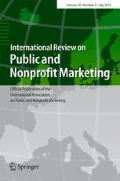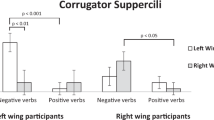Abstract
Political humor is a wise communicative strategy for politicians to use. However, previous research has not linked politicians’ use of political humor with voter’s emotional reaction and visual attention. Two experiments were conducted using facial expression analysis and eye-tracking technology to record the emotional reaction and visual attention of participants while watching one of the two presidential debates broadcast during the second round of the 2016 presidential election campaign in Peru. Results showed that voters’ educational level, candidates’ facial expressions while expressing the political humor, the type of camera shot displayed and the debate’s audience laughs influence voter’s positive emotional reaction and visual attention to instances of political humor.






Similar content being viewed by others
Notes
We did not analyze the influence of participants’ gender because there is no evidence of gender differences concerning reactions to political humor (Bippus, 2007). Moreover, we did not analyze voter’s political preference or partisanship because, first, Bippus (2007) found that voter’s partisanship did not affect the perceived effectiveness of the humor. Second, given the multi-party Peruvian electoral system, Peruvian voters’ partisanship is a volatile sociodemographic characteristic.
None of the coders were compensated for their time and they were not attached to the research project because of their minor contribution to the entire project.
References
Anderson, R., & Klofstad, C. (2012). Preference for Leaders with Masculine Voices Holds in the Case of Feminine Leadership Roles. Plos One 7(12).
Attardo, S., Eisterhold, J., Hay, J., et al. (2003). Multimodal markers of irony and sarcasm. Humor, 16(2), 243–260.
Baum, M. A. (2005). Talking the vote: Why presidential candidates hit the talk show circuit. American Journal of Political Science, 49, 213–234.
Becerra, M. G. (2016). El voto emocional. Un análisis del rol de las emociones en el comportamiento político del elector peruano. Bachelor’s Thesis. Available in http://repositorio.pucp.edu.pe/index/handle/123456789/54905
Bippus, A. (2007). Factors predicting the perceived effectiveness of politicians' use of humor during a debate. Humor: International Journal of Humor Research, 20, 105–121.
Bucy, E. (2016). The Look of Losing, Then and Now: Nixon, Obama, and Nonverbal Indicators of Opportunity Lost. American Behavioral Scientist, 60(14), 1772–1798.
Bucy, E., & Bradley, S. (2003). Presidential expressions and viewer emotion: counter empathic responses to televised leader displays. Social Science Information 43(1): 59–94; 040689.
Cao, X. (2008). Political comedy shows and knowledge about primary campaigns: The moderating effects of age and education. Mass Communication and Society, 11(1), 43–61.
Carpenter, D. M., Webster, M. J., & Bowman, C. K. (2019). White House wit: How presidents use humor as a leadership tool. Presidential Studies Quarterly, 49(1), 23–55.
Crawford, C. B. (1999). Analysis of humor in the 1992 presidential debates. Perceptual and Motor Skills, 88, 417–420.
Davis, J. L., Love, T. P., & Killen, G. (2018). Seriously funny: The political work of humor on social media. New Media & Society, 20(10), 3898–3916.
Doumbouya, R. L. (2017). Analyse des émotions dans un jeu vidéo. Magister thesis, Université de Montréal.
Dumitrescu, D. (2016). Nonverbal communication in politics: A review of research developments, 2005–2015. American Behavioral Scientist, 60(14), 1656–1675.
Eisterhold, J., Attardo, S., & Boxer, D. (2006). Reactions to irony in discourse: Evidence for the least disruption principle. Journal of Pragmatics, 38(8), 1239–1256.
Elenbaas, M., & De Vreese, C. H. (2008). The effects of strategic news on political cynicism and vote choice among young voters. Journal of Communication, 58(3), 550–567.
Flamson, T., & Barrett, H. C. (2008). The encryption theory of humor: A knowledge-based mechanism of honest signaling. Journal of Evolutionary Psychology, 6(4), 261–281.
Graham, C., & Kane, C. (1998). Opportunistic government or sustaining reform? Electoral trends and public-expenditure patterns in Peru, 1990–1995. Latin American Research Review, 33(1), 67–104.
Grebelsky-Lichtman, T. (2015). The Role of Verbal and Nonverbal Behavior in Televised Political Debates. Journal of Political Marketing.
Gruner, C. R. (1967). Effect of humor on speaker ethos and audience information gain. Journal of Communication, 17(3), 228–233.
Harrison, Z., & Bucy, E. (2016). When style obscures substance: Visual attention to display appropriateness in the 2012 presidential debates. Communication Monographs.
Heiss, R., Schmuck, D., & Matthes, J. (2019). What drives interaction in political actors’ Facebook posts? Profile and content predictors of user engagement and political actors’ reactions. Information, Communication & Society, 22(10), 1497–1513.
IPSOS. (2016). Opinión Data - May 29, 2016, La Favorita. Retrieved from https://www.ipsos.com/sites/default/files/publication/2016-05/Opinion%20Data%20Mayo%20IV%202016.pdf
Keller, T. R., & Kleinen-von Königslöw, K. (2018). Pseudo-discursive, mobilizing, emotional, and entertaining: identifying four successful communication styles of political actors on social media during the 2015 Swiss national elections. Journal of Information Technology & Politics, 15(4), 358–377.
Kendon, A. (1967). Some functions of gaze-direction in social interaction. Acta psychologica, 26, 22–63.
Kendon, A., & Cook, M. (1969). The consistency of gaze patterns in social interaction. British Journal of Psychology, 60(4), 481–494.
Klofstad, C., Anderson, R., & Nowicki, S. (2015). Perceptions of Competence, Strength, and Age Influence Voters to Select Leaders with Lower-Pitched Voices. Plos One.
Klofstad, C., Anderson, R., & Peters, S. (2012). Sounds like a winner: voice pitch influences perception of leadership capacity in both men and women. Proceedings of the royal society, 279, 2698–2704.
Klofstad, C. A. (2016). Candidate voice pitch influences election outcomes. Political Psychology, 37(5), 725–738.
Koppensteiner, M., Stephan, P., & Jäschke, J. (2015). From body motion to cheers: Speakers’ body movements as predictors of applause. Personality and Individual Differences, 74, 182–185.
Kulkarni, A. (2017). Internet meme and Political Discourse: A study on the impact of internet meme as a tool in communicating political satire. Journal of Content, Community & Communication Amity School of Communication, 6.
Lautsen, L., & Bang, M. (2015). Winning Faces Vary by Ideology: Nonverbal Source Cues Influence election and communication success in politics. Political Communication, 00, 1–24.
Lee, H., & Kwak, N. (2014). The affect effect of political satire: Sarcastic humor, negative emotions, and political participation. Mass Communication and Society, 17(3), 307–328.
López-Meri, A., Marcos-García, S., & Casero-Ripollés, A. (2017). What do politicians do on Twitter? Functions and communication strategies in the Spanish electoral campaign of 2016. El profesional de la información, 26(5), 795–804.
Madestam, J., & Falkman, L. L. (2017). Rhetorical construction of political leadership in social media. Journal of Organizational Change Management.
Maurer, M. (2016). Nonverbal Influence During Televised Debates: Integrating CRM in Experimental Channel Studies. American Behavioral Scientist, 60(14), 1799–1815.
McHugh, M. L. (2012). Interrater reliability: the kappa statistic. Biochemia medica: Biochemia medica, 22(3), 276–282.
Mileti, A., Guido, G., & Prete, M. I. (2016). Nanomarketing: a new frontier for neuromarketing. Psychology & Marketing, 33(8), 664–674.
Nagel, F., Maurer, M., & Reinemann, C. (2012). Is There a Visual Dominance in Political Communication? How Verbal, Visual, and Vocal Communication Shape Viewers’ Impressions of Political Candidates. Journal of communication 2012.
Nave, N. N., Shifman, L., & Tenenboim-Weinblatt, K. (2018). Talking it personally: Features of successful political posts on Facebook. Social Media+ Society, 4(3), 2056305118784771.
Nuolijärvi, P., & Tiittula, L. (2011). Irony in political television debates. Journal of Pragmatics, 43(2), 572–587.
ONPE. (2016). segunda elección presidencial 2016: resultados presidenciales. Accessed August 2019, https://www.web.onpe.gob.pe/modElecciones/elecciones/elecciones2016/PRP2V2016/Resultados-Ubigeo-Presidencial.html#posicion
Ortigueira-Sánchez, L. C., & Cárdenas-Egúsquiza, A. L. (2019). Rhetorical strategies and emotions in political marketing management. Academia Revista Latinoamericana de Administración.
Panagopoulos, C. (2008). The calculus of voting in compulsory voting systems. Political Behavior, 30(4), 455–467.
Pal, J. (2017). Studying political communication on Twitter: the case for small data. Current opinion in behavioral sciences, 18, 97–102.
Peifer, J. T., & Holbert, R. L. (2013). Developing a systematic assessment of humor in the context of the 2012 US general election debates. Argumentation and Advocacy, 49(4), 286–300.
Provine, R. R. (1992). Contagious laughter: Laughter is a sufficient stimulus for laughs and smiles. Bulletin of the Psychonomic Society, 30(1), 1–4.
Provine, R. R. (2016). Laughter as a scientific problem: An adventure in sidewalk neuroscience. Journal of Comparative Neurology, 524(8), 1532–1539.
Rhea, D. M. (2011). There they go again: The use of humor in presidential debates 1960–2008. Argumentation and Advocacy, 49, 115–131.
Ruch, W., McGhee, P. E., & Hehl, F. J. (1990). Age differences in the enjoyment of incongruity-resolution and nonsense humor during adulthood. Psychology and aging, 5(3), 348.
Saks, J., Compton, J., Hopkins, A., et al. (2016). Dialed In: Continuous Response Measures in Televised Political Debates and Their Effect on Viewers. Journal of Broadcasting & Electronic Media 60:2: 231–247.
Sánchez-Sibony, O. (2012). The 2011 presidential election in Peru: a thorny moral and political dilemma. Contemporary Politics, 18(1), 109–126.
Stewart, P. (2010). Presidential laugh lines: Candidate display behavior and audience laughter 2008 debates. Politics and the life sciences, 29(02), 55–72.
Stewart, P., & FordDowe, P. (2013). Interpreting President Barack Obama’s Facial Displays of Emotion: Revisting the Dartmouth Group. Political Psychology 34 (3).
Stewart, P., Bucy, E., & Mehu, M. (2015). Strengthening bonds and connecting with followers A biobehavioral inventory of political smiles. Politics and the Life Science, 34(1), 73–92.
Stewart, P., Wallet, B., & Schubert, J. (2009). Presidential speechmaking style: Emotional response to micro-expressions of facial affect. Motivation and Emotion, 33, 125–135.
Stewart, P. A. (2011). The influence of self-and other-deprecatory humor on presidential candidate evaluation during the 2008 US election. Social Science Information, 50(2), 201–222.
Stewart, P. A., Eubanks, A. D., Dye, R. G., et al. (2017). Visual Presentation Style 2: Influences on Perceptions of Donald Trump and Hillary Clinton Based on Visual Presentation Style During the Third 2016 Presidential Debate. American Behavioral Scientist, 61(5), 545–557.
Stewart, P. A., Eubanks, A. D., & Miller, J. (2016). “Please clap”: Applause, laughter, and booing during the 2016 GOP presidential primary debates. PS: Political Science & Politics, 49(4), 696–700.
Sülflow, M., & Maurer, M. (2019). The Power of Smiling. How Politicians’ Displays of Happiness Affect Viewers’ Gaze Behavior and Political Judgments. In Visual Political Communication (pp. 207–224). Palgrave Macmillan, Cham.
Tigue, C., Borak, D., O’Connor, J., et al. (2012). Voice pitch influences voting behavior. Evolution and Human Behavior, 33, 210–216.
Weber, M., & Quiring, O. (2017). Is It Really That Funny? Laughter, Emotional Contagion, and Heuristic Processing During Shared Media Use. Media Psychology 1–23.
Wells, C., Van Thomme, J., Maurer, P., Hanna, A., Pevehouse, J., Shah, D. V., & Bucy, E. (2016). Coproduction or cooptation? Real-time spin and social media response during the 2012 French and US presidential debates. French Politics, 14(2), 206–233.
Author information
Authors and Affiliations
Corresponding author
Additional information
Publisher's Note
Springer Nature remains neutral with regard to jurisdictional claims in published maps and institutional affiliations.
Rights and permissions
About this article
Cite this article
Ortigueira-Sánchez, L.C., Cárdenas-Egúsquiza, A.L. Political leadership, a quasi-experimental study of Peruvian voters’ emotional reaction and visual attention to political humor. Int Rev Public Nonprofit Mark 19, 101–126 (2022). https://doi.org/10.1007/s12208-021-00293-4
Received:
Accepted:
Published:
Issue Date:
DOI: https://doi.org/10.1007/s12208-021-00293-4




